Lord of the Rings Online: Shadows of Angmar Review
Lord of the Rings Online: Shadows of Angmar
Does WoW finally have a real competitor? Stuart Andrews casts his Sauron-like gaze upon the Shadows of Angmar.
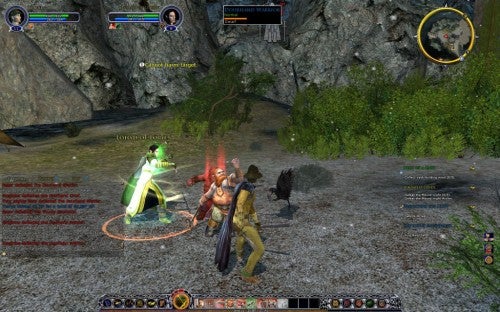
Verdict
Key Specifications
- Review Price: £23.99
This is what we feared: a crap World of Warcraft clone with hairy hobbit feet; a superficial theme park trip through Tolkien’s Middle Earth; another lifeless, old-school MMO relying on the fantasy world’s biggest license for mass appeal; a game that fails to do justice to either Lord of the Rings or Turbine’s heritage as a world-class MMO developer.

Here is what we’ve got: an excellent, third-generation MMO that’s not shy of taking inspiration from the mighty World of Warcraft, but that has a few great ideas of its own; a game that explores and expands Middle Earth in ways that Tolkien might never have intended, yet still captures much of the spirit of his creation; the first fantasy MMO that can actually give Blizzard’s behemoth a run for its money.
Of course – as some of the moaners keep on pointing out – the overall look and feel is very, very similar to WoW. If you’ve played it – or Guild Wars, City of Heroes, Vanguard or EverQuest II – then the placement of icons along the bottom of the screen and the use of the Quest Log, Character Sheet and inventory isn’t going to give you any major surprises. Still, WoW hardly invented this interface – it merely polished and enhanced it – and if the result is that anyone who’s played another MMO can pick up and play LOTRO in minutes, then Turbine really has nothing to be ashamed of. After all, we don’t complain that a Word Processor feels too much like Word or an image-editor feels too much like Photoshop. Why should we as long as it’s easy to use?
True, the same charge also holds water with the basic game mechanics. Yes, as in WoW, Guild Wars, Vanguard et al, playing LOTRO is frequently a case of finding a non-player character (NPC) with a glowing icon above their head (here a ring instead of a question mark) then following their instructions to find one or more creatures of a particular type. You then target these creatures in turn, and click on the icons at the bottom of the screen (or batter the hotkeys) until they’re dead and you can loot their gently glowing corpses. Alternatively, you might have to deliver an item or message or collect a particular object from the environment, but whichever the case, your next step is invariably to return to your friendly quest-giver for a reward. In other words, if you were expecting some vast innovation in MMO gameplay from LOTRO then I’m afraid you are likely to be disappointed. In some respects – particularly its combat and diplomacy systems – Vanguard was actually a more progressive game.
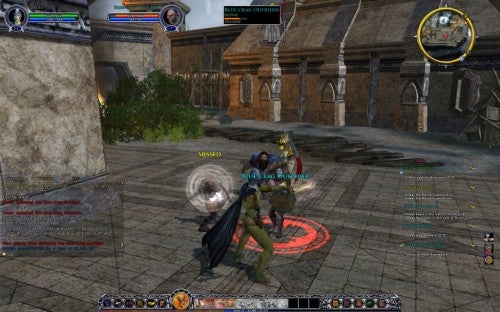
To be perfectly blunt, then, the experience of playing LOTRO is not a million miles from the experience of playing WoW. But like WoW, the brilliance of the game is not in its reinvention of the MMO genre, but in the way that it polishes, extends and streamlines the style and the mechanics to build something most of us will warm to in the short-term, and should grow to love as time goes on.
A lot of that welcome comes down to Middle Earth itself. With the novels, the films, the board games, the old paper-based role-playing game and several existing video games already out there, Middle Earth has a familiarity factor that other fantasy MMOs – WoW aside – can only dream of. Of course, this is a double-edged sword: it also means that LOTRO’s Middle Earth has a lot to live up to. Luckily, Turbine has barely put a foot wrong. I doubt this is a Middle Earth Tolkien would recognise or approve of; there are too many hobbit warriors and malicious wights and goblins wandering around for that. However it is one that is evocative of his writings, the illustrations of Alan Lee, John Howe and others – not to mention Peter Jackson’s films – without feeling like a slavish, unplayable recreation.
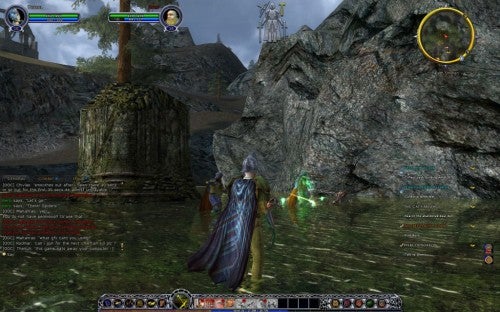
The landscapes are epic and expansive, the elven cities full of intricate design and wispy architecture, the shire towns as rustic and bustling with merriment as you might expect. There is a huge buzz when you wander through Bree, discover Elven ruins in the forests or enter the gates of a deserted Dwarven city for the first time. Kudos goes to Turbine’s art team for the way it has brought all these influences to life, and expanded them into a world you could explore for months at a time.
Plaudits also go to whoever did the work on NPCs. In the vast majority of MMOs NPCs are generic goons who stand around like lemons in central areas with their sole interest in life being to dole out quests or assist with basic training or trading functions. Well, in LOTRO they are still found standing in central areas and, true, they are still handing out quests and handling logistics, but the difference is that, this time, they do it with some modicum of personality. With their back stories and changing motivation, they’re one more element that helps stitch the whole fiction together.
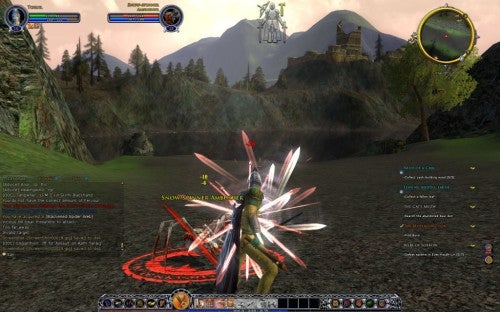
The quests themselves are right up there with the best of WoW and Guild Wars in terms of wrapping fairly basic instructions (kill this, collect that) in an interesting narrative package. There is a lot of text to wade through at times, but it includes some deft humour and atmospheric dialogue, and the game continually implies the brooding fears – who are the black riders? Why are the goblins crawling out of hiding? What black forces lie behind the treacherous Dourhand dwarves? – that we all know will link into the wider tale of the War of the Ring. What’s more, all that text means you get a lot of information, and as a result you rarely find yourself wandering willy-nilly looking for a goblin encampment or nest of spiders. Better still, you can always use the handy quest-tracker on the right-hand side of the screen to give you basic info on your current missions. Click on your current main quest, and you’ll find all the info you need in seconds.
But LOTRO isn’t just about grinding and levelling; it’s also about making you feel part of an ongoing, epic story. To further this aim, it makes use of instance-based narrative missions, where you (and often a group of other players) follow an important NPC on a mission that takes the overall story arc to its next logical point. These are used sparingly and wisely to give you a feeling of plot development, and you’re under no pressure to take them until you’ve had your fill of the regular quests littering each region.
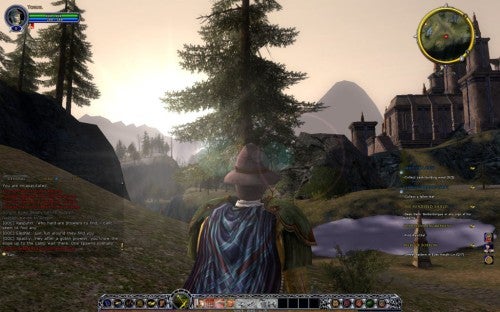
That’s good, because the game gives you no shortage of reasons to make the most of every part of Middle Earth. Even more than WoW, there’s a sense that wherever you go and whatever you do, you will be richly rewarded for your efforts. For one thing, as you explore certain areas or defeat certain enemies, you open up new ‘deeds’. You might complete one by killing so many goblins in a region, or another by finding four major elven ruins, but in any case it might lead to an attribute bonus or a brand new title. The latter is a particularly cool feature: just select a title from your ever-growing selection, and all who meet you will see the legend ‘Defender of Ered Luin’ or ‘Web Slasher’ floating above your head. Add in some great reward arms and armour for completing specific missions, and it’s not long before you feel like you’re building a legend all your own.
What’s more, the game hits an almost perfect balance between group and solo play. Without cheating (as Guild Wars: Nightfall does) with henchmen or AI heroes, LOTRO probably has more solo-friendly content than any other MMO I’ve played, and if you just want an hour or two of action without any complications, you can always find a few quests to keep you occupied (and the quest log actually distinguishes between solo-friendly and group-oriented mission). However, finding a fellowship brings benefits in terms of group combat capabilities, and is an essential part of some of the instance-based narrative missions. It can also save you time queuing at particular mission points. One of the few regrettable vestiges of the old-school MMO you’ll encounter in LOTRO is the odd small period of hovering while the goblin chief returns from the grave or the lost dwarf cook finds his way back into peril.
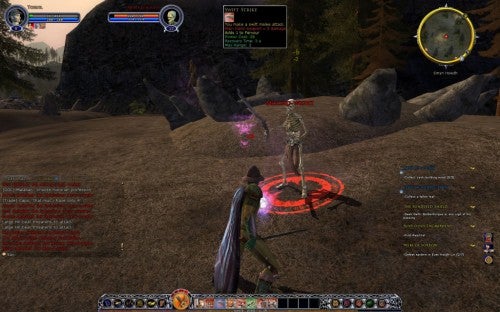
The good news here is that the game makes it easy to locate groups via the chat and social windows, and that it seems to be standard practice to hook up for a single mission if you want then disperse to collect the rewards. If you don’t want to make friends for the MMO’s life, you can dip in and dip out as you please.
Does LOTRO have any drawbacks? Well, there are the usual stability issues that any new MMO seems to go through in its first few weeks, and I have encountered a few problems with the client on Windows Vista. Long-term, the biggest concern may be player choice. With only four races and seven classes (some of which aren’t open to all races) there is already a slight feeling that the game doesn’t offer enough variety, and only two of the classes will suit those who prefer wielding magic to swinging a sword. On the plus side, with skills, deeds, costumes and titles there is still plenty of stuff with which to differentiate your adventurer, and at least the classes and races used give the game an authentic Tolkien feel – it would have been awful had LOTRO succumbed to the regular D&D archetypes.
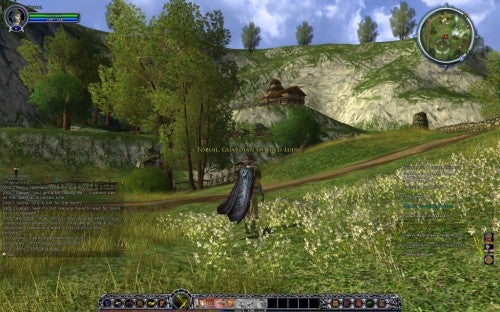
Overall, you can’t escape the fact that in many respects LOTRO presents a new high water mark for MMOs. Visually, it’s easily the most accomplished, marrying Vanguard’s glossy new shader effects to a production design that can match World of Warcraft’s. It even outdoes Guild Wars for vistas of pure scenic beauty. The music is stirring and fantastic, and the whole presentation is simply top notch. Above all else, however, it’s the intangibles that make LOTRO so good. It has the elusive quality that every MMO desperately needs – a real buzz – with busy servers packed full of people who are clearly having a good time. The atmosphere reminds me of the early days of WoW, with players happy to help each other out, and no shortage of happy-go-lucky heroes ready to lend a hand when the forces of darkness overwhelm a lone adventurer. Maybe the usual snobbery and guild (here kinship) one-upmanship will grow with time, but at the moment LOTRO is the freshest and most amiable MMO around.
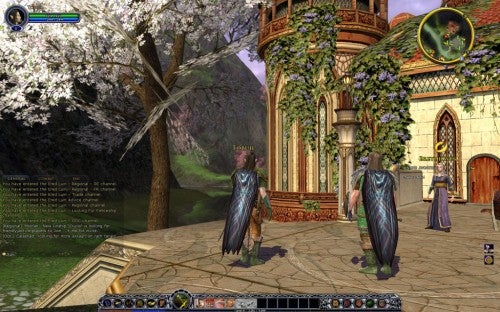
Does that mean it’s better than WoW? Frankly, at this point it’s far too early to say. WoW has grown richer and deeper with time, and it’ll take more than a few weeks before we can say whether LOTRO has its long-term staying power. Its lack of races and classes may eventually prove telling, and nobody knows how far or how deep the experience goes. In addition, until we try its PvP option – not available until higher levels – we won’t know how it matches WoW in that sphere. For newcomers to the genre or disaffected WoW veterans, however, it’s hard to think of anything better. For me, and for the foreseeable future, this will certainly be my MMO of choice. Try it, and I’ll be surprised if you don’t come to the same decision.
”’Verdict”’
An MMO that does justice to Middle Earth, and the first to get in range of matching Blizzard’s towering benchmark in the genre. Whether you’re a newbie, a Tolkien-nut or a hardened online warrior, LOTRO has what you’re looking for.

